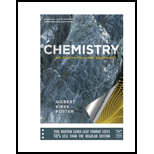
To find:
a) Molar mass of caffeine.
b) Molecular formula of caffeine.
Answer to Problem 11.76QA
Solution:
a) The molar mass of caffeine is 193.97 g/mol.
b) The molecular formula of caffeine is C8H10N4O2.
Explanation of Solution
1) Concept:
2) Given:
i) Mass of caffeine solution = 150 mg
ii) Solvent used =10.0 g camphor = 0.01 kg (since 1 kg = 1000 g)
iii)
iv)
v) Caffeine is a non-electrolyte. This suggests that, the van’t Hoff factor (i) for caffeine acid is 1.
vi) % Mass of C = 49.49
vii) % Mass of H = 5.15
viii) % Mass of N = 28.87
3) Formula:
Formula for depression in freezing point is:
Where,
Formula for molality is:
4) Calculations:
a)
Calculate Molar mass of Caffeine:
Solving above equation for molality, we get,
We find moles of solute caffeine using calculated molality and mass of solvent as:
Molar mass is the mass in grams per mole of that substance, so it will be:
The molar mass of Caffeine is
b)
Molecular formula of caffeine:
Given:
% Mass of C
% Mass of H
% Mass of N
Consider the mass of caffeine
Therefore,
And remaining is Oxygen
i. Calculate mass of oxygen:
From these given masses we would find out mass of oxygen as,
ii. Calculate moles of each atom:
We can calculate the moles of each using the mass in g.
iii. Find out empirical formula:
Comparing moles of C, H and O, we observe that moles of O are the least. So, atoms of C, H and O are calculated by dividing each of the moles by least amount of moles.
Thus empirical formula for caffeine is C4H5N2O.
iv. Find out molecular formula:
We have calculated the molar mass of caffeine in part a) =
The molar mass of caffeine is 193.97 g/mol.
The molecular formula of caffeine is C8H10N4O2.
Conclusion:
Freezing point depression is a colligative property which is useful in determining the molar mass of the solute in a solution. Using stoichiometry between a compound and its constituent elements, one can determine the empirical formula and molecular formula of the unknown substance.
Want to see more full solutions like this?
Chapter 11 Solutions
Chemistry: An Atoms-Focused Approach
 ChemistryChemistryISBN:9781305957404Author:Steven S. Zumdahl, Susan A. Zumdahl, Donald J. DeCostePublisher:Cengage Learning
ChemistryChemistryISBN:9781305957404Author:Steven S. Zumdahl, Susan A. Zumdahl, Donald J. DeCostePublisher:Cengage Learning ChemistryChemistryISBN:9781259911156Author:Raymond Chang Dr., Jason Overby ProfessorPublisher:McGraw-Hill Education
ChemistryChemistryISBN:9781259911156Author:Raymond Chang Dr., Jason Overby ProfessorPublisher:McGraw-Hill Education Principles of Instrumental AnalysisChemistryISBN:9781305577213Author:Douglas A. Skoog, F. James Holler, Stanley R. CrouchPublisher:Cengage Learning
Principles of Instrumental AnalysisChemistryISBN:9781305577213Author:Douglas A. Skoog, F. James Holler, Stanley R. CrouchPublisher:Cengage Learning Organic ChemistryChemistryISBN:9780078021558Author:Janice Gorzynski Smith Dr.Publisher:McGraw-Hill Education
Organic ChemistryChemistryISBN:9780078021558Author:Janice Gorzynski Smith Dr.Publisher:McGraw-Hill Education Chemistry: Principles and ReactionsChemistryISBN:9781305079373Author:William L. Masterton, Cecile N. HurleyPublisher:Cengage Learning
Chemistry: Principles and ReactionsChemistryISBN:9781305079373Author:William L. Masterton, Cecile N. HurleyPublisher:Cengage Learning Elementary Principles of Chemical Processes, Bind...ChemistryISBN:9781118431221Author:Richard M. Felder, Ronald W. Rousseau, Lisa G. BullardPublisher:WILEY
Elementary Principles of Chemical Processes, Bind...ChemistryISBN:9781118431221Author:Richard M. Felder, Ronald W. Rousseau, Lisa G. BullardPublisher:WILEY





